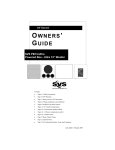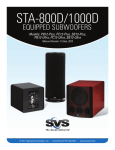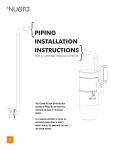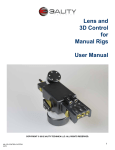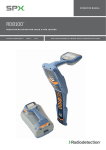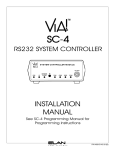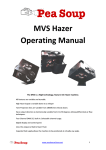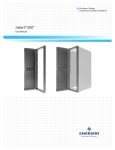Download SV Sound SB12-Plus Speaker User Manual
Transcript
SV Sound OWNERS’ GUIDE SVS SB12-Plus Small Box — Plus 12” Woofer Contents: Chapter 2 Safety instructions Chapter 3 SVS Welcome Chapter 4 About your SVS subwoofer Chapter 5 General subwoofer features Chapter 6 Setup, integration, and calibration Chapter 7 Room compensation control Chapter 8 Parametric equalizer (PEQ) Chapter 9 Subwoofer specifications Chapter 10 Terms and Conditions Last update: 27 April, 2008 SV Sound Chapter 2-1 IMPORTANT SAFETY INSTRUCTIONS 1. Read these instructions. 2. Keep these instructions. 3. Heed all warnings. 4. Follow all instructions. 5. Do not use this apparatus near water. 6. Clean only with dry cloth. 7. Do not block any ventilation openings. Install in accordance with the manufacturer's instructions. 8. Do not install near any heat sources such as radiators, heat registers, stoves, or other apparatus (including amplifiers) that produce heat. 9. Do not defeat the safety purpose of any polarized or grounding-type plug. A polarized plug has two blades with one wider than the other. A grounding type plug has two prongs and a third grounding point. The wide blade or the third prong are provided for your safety. If the provided plug does not fit into your outlet, consult an electrician for replacement of the obsolete outlet. 10. Protect the power cord from being walked on or pinched particularly at plugs, convenience receptacles, and the point where they exit from the apparatus. 11. Only use attachments/accessories specified by the manufacturer. Use only with the cart, stand, tripod, bracket, or table specified by the manufacturer, or sold with the apparatus. When a cart is used use caution when moving the cart/apparatus combination to avoid injury from tip-over. Chapter 2-2 SV Sound 13. Unplug this apparatus during lightning storms or when unused for long periods of time. 14. Refer all servicing to qualified service personnel. Servicing is required when the apparatus has been damaged in any way, such as powersupply cord or plug is damaged, liquid has been spilled or objects have fallen into the apparatus, the apparatus has been exposed to rain or moisture, does not operate normally, or has been dropped. 15. WARNING: To reduce the risk of fire or electric shock, this apparatus should not be exposed to rain or moisture and objects filled with liquids, such as vases, should not be placed on this apparatus. 16. To completely disconnect this equipment from the mains, disconnect the power supply cord plug from the receptacle. 17. The mains plug of the power supply cord shall remain readily operable. The lightning flash with arrowhead symbol within an equilateral triangle, is intended to alert the user to the presence of un-insulated "dangerous voltage " within the product's enclosure that may be of sufficient magnitude to constitute a risk of electric shock to persons. The exclamation point within an equilateral triangle is intended to alert the user to the presence of important operating and maintenance (servicing) instructions in the literature accompanying the product. Page 4 SV Sound Chapter 3 SV Subwoofers Welcome! At SVS, you can actually hear the tireless research and design efforts built in to our subwoofers and speakers. Years are spent developing any SVS product — with work typically spanning from our Ohio headquarters… to US west coast technology centers… and over to the finest component suppliers in Asia and Europe as well. Nothing in our speaker offerings is an ―off the shelf‖ product. SVS is committed to making better sound systems with elegant looks, robust construction and world-class technology and materials. We believe you deserve nothing less. This manual and the printed ―Quick Start‖ sheet will help you integrate speakers and subwoofer quickly and with professional results. Armed with only a few basic tools, such a sound pressure level (SPL) meter, and the test tones built in to most audio/video receivers (AVR), you will achieve smooth, detailed and powerful reproduction of all your favorite music and movie audio. Expect to hear things you never heard before… and expect not to hear some of the artifacts you might have accepted in the past with inferior brands. Have a question about your surround sound system? For more information about SVS products check out our US website, or the exclusive dealer for your region, contact us via phone or e-mail should you have questions regarding our products. SVS was founded by audio enthusiasts — our commitment to service is the only thing that rivals the products we create. Our resellers around the world feel the same way. The SVS Team, Ohio, USA September, 2008 www.svsound.com SV SV Subwoofers Sound Chapter 4 About your SVS Subwoofer There maybe be other subwoofers that look like them, but virtually none work like them. SVS subwoofers are decidedly different in how they are designed, produced, sold, and the exceptionally high quality components we use. You could have spent much more on other brands and still not come close to the performance our products provide. What makes a subwoofer an SVS? Quality components, sane prices. You might be surprised at how inexpensive the components in some not-so-inexpensive subwoofers are. At SVS, performance is king... not cutting a few dollars from our ―cost to build‖. Innovative designs, rich materials. We test all our materials, and features in the real world, and test size and shape, before any design is deemed ready. Cabinet construction must ensure rigid and durable products. All our subwoofers offer computer controlled panel cutting, steel fasteners, and recessed components. Tap the side of your sub, look at the solid construction or remove your grill, and you’ll know what we mean. Sealed, or vented, down-firing or front-firing cabinets. An SVS tradition is to offer a variety of ―form factors‖ which provide exceptional performance yet also a compact ―foot print‖ which complements your room style. Features and controls. Variable phase, crossovers which can be defeated, and on select models, variable tuning, equalizers or other advanced controls are built in to allow customers to make their SVS fit their needs. Spend time exploring this guide and contact your dealer if you require assistance on any feature. World class power. Our advanced amplifiers are designed and manufactured with a level of fit and finish, and genuine power which is rare at our competitive prices. Loaded with comprehensive of easy to use controls, and our tremendously efficient Ohio-built woofers, all our subs achieve exceptional depth, tremendous power and flat, natural sound. Hear everything on your music CD’s and DVD’s with SVS products.. Chapter 5-1 SV Sound Powered Subwoofer Common Features. SVS subwoofer amps use the most durable and accurate designs possible. Get familiar with yours! Volume/Gain Use ―gain‖ (in conjunction with your Audio Video Receiver (AVR) subwoofer output level control) to achieve bass level calibration to your liking. Start your setup with the sub’s volume/gain no more than 1/4 to 1/3 of the way up (turned clockwise from the left). Crossover Frequency. If you use your AVR’s internal crossover to manage bass frequencies (highly recommended), the setting of this knob on your SVS sub is irrelevant. (Note: Use the sub’s crossover ―Enable/Disable‖ switch discussed below to take advantage of this configuration.) Phase. Think of long bass waves as conflicting or enhancing each other, depending on the timing of their arrival at your listening location (either together, or not). Set phase to zero if your AVR offers settings for the distance from your seat to your subwoofer. Adjust in small steps for smooth sound with music playing if your AVR lacks a subwoofer distance setting. Line In/Out. Use either of the sub’s ―Line In‖ jacks (RCA or XLR type) to connect the subwoofer to the output jack of your AVR. Feeding just one input is enough. If you are using a conventional amp and/or a stereo setup you can use the ―Line Out‖ jacks to send sound (filtered of deep bass information) back to your system amp, or switch off this filter. A simple RCA signal cable is all you need for either type configuration. See ―Crossover Feature‖ discussion below for more on Line Out options. Auto-On. Your Powered Box allows itself to be in an ―Auto-On‖ mode… or ―On‖ all the time. With the former setting (the switch in the ―Auto‖ position) your subwoofer will ―sense‖ that a DVD or CD etc. has begun and switch its audio circuits on immediately (the ―hard‖ power switch mentioned below must be set to ―on‖, naturally). A few minutes after a movie, the Auto-On light will turn from Green to Red, switching portions of the sub’s power supply back off. Chapter 5.2 SV Sound Sometimes, with very low listening levels, your subwoofer might not get enough of a bass signal from your AVR to ―trip‖ the Auto-On circuit. Should you ever find this to be the case you may leave this switch to ―On‖, or turn up the AVR’s subwoofer level some (be sure to recalibrate channels levels with your sound meter afterwards). Crossover Feature Switches. If you allow your DD/DTS surroundsound receiver or processor to manage bass frequencies (again, highly recommended), this switch should be set to ―Disabled‖, eliminating the effects of the ―Crossover Frequency‖ knob and allowing your sub to reproduce just what is fed from the receiver. If you use the sub in a two channel (stereo only) configuration, then ―Enable‖ the crossover and adjust the knob to best blend the sub into the output of your speakers. Power. This heavy-duty two-position switch next to the power cord will completely cut the power to your sub amp. Flip this switch to off before you ever move the sub or change inputs or outputs. Do not plug this sub into receiver convenience power outlets. Allow five minutes of ―off‖ time before switching back ―on‖. Fuse. User replaceable, contact your dealer if you have trouble finding one. The fuse can be accessed by a small door immediately next to the power cord fitting (where you should also find a spare one for your use). Read ahead for advanced features including Room Compensation, and Parametric Equalization (PEQ). SV SV Subwoofers Sound Chapter 6-1 Setup, calibrating and integration What’s to know? Setup is easy! However, there are key steps which must be done carefully and correctly, read on: Unpacking. Take a few moments to carefully unpack everything. Save the box and shipping materials, just in case you need to return the sub for any reason. Location. Where you put a sub is important to how it will sound. Use a corner if you can, and avoid putting your sub where it might adjoin large open areas. Studies have shown that the deepest and flattest bass response is typically attained when a subwoofer is placed within a few feet of one of your room’s corners (leave about 3‖ in the back for cable clearance with any wall or other surface). Whether you put the sub in front or to the rear of your room makes surprisingly little difference. Hook-up (see Fig. 1). There are a variety of ways to configure your new sub. Usually, a simple mono, shielded 75 Ohm A/V RCA or XLR type cable (a.) is used to take the subwoofer output of your AVR (b.) and feed one low-level input of the sub’s amp. There is no need to ―split‖ the signal going to the sub (c.). You can feed either one of the two amp inputs, it doesn’t matter, right or left. NOTE: Take time to review your AVR manual. Ensure all power to your equipment is off when making these connections. Also, be certain your power outlet can handle a minimum of 500 watts. (Use of ―convenience outlets‖ on receivers are not recommended for your sub). (a.) (b.) (c.) DD/DTS Processor/ Receiver Fig. 1 SV SV Sound Sound Chapter 6-2 More Setup, calibrating and integration If you are running a pair of SVS subwoofers (Fig. 2), you will need to use an inexpensive ―Y‖ cable adapter (d.) From the ―Y‖ cable you can run a standard 75 Ohm RCA signal cable (e.) to each sub, thus ―splitting‖ the Low Frequency Effects (LFE) and other bass from your receiver, and effectively feeding both subwoofers with the same signal. NOTES: Determine if you want ―ON‖ (always on) or ―AUTO ON‖ which turns your sub on only when a bass signal is present. High power amp designs can require five minutes of ―OFF‖ time before sub will resume ―ON‖ status again. (e.) ―Y‖ cable/splitter from AVR (d.) Fig. 2 AVR (Subwoofer ―Out‖) jack RCA/XLR ―Calibration‖ isn’t only for technically minded sound enthusiasts. It is ’s critical to a proper configuration of your home audio system. Fortunately, adjusting channel balance (essentially all ―calibration‖ amounts to) is simple to do. The first requirement is to ensure your AVR is ready. Thus we recommend you consult your AVR manual to review the choices you have regarding setup. Generally, this requires your receiver’s test tones play back at the same volume from each of your system’s speakers. Of course this can include speakers at left, center, right, left surround and right surround plus the subwoofer itself. Some things to check as you get ready to calibrate: Are your speakers set correct to the correct “size”? Your AVR should allow you to your speakers be set to ―Small‖ or ―Large‖. Selecting the size accordingly will ensure bass goes to most appropriate speakers, and use the subwoofer correctly too. ―Small‖ is nearly always the best configuration with a good subwoofer. Chapter 6-3 SV Sound Also, is your subwoofer turned ―ON‖? We don’t mean ―is your subwoofer amplifier on?‖ but rather, is your AVR sending a bass signal to your sub amp? This can only happen if you say ―Yes‖ (or ―ON‖) in the ―Subwoofer‖ selection during the setup of your AVR’s setup menu. Is your receiver connected to the sub amp? Use a well-shielded ―RCA‖ or XLR cable (sometimes called a ―patch cord‖) to connect the subwoofer output of your AVR to either input jack of your subwoofer’s dedicated amp. Again, you’ll need to ―split‖ the bass signal with a ―Y Cable‖ if you have a pair of subs. But you only need feed one of the two inputs (it doesn’t matter either Right or Left) of any SVS Powered Box sub. Is your Radio Shack ® sound pressure level (SPL) meter ready? This tool is absolutely essential to proper home audio setup. It’s akin to a tire pressure gauge for your car. Set the meter to ―Slow‖ and ―C-weighting‖ (and turn the dial to 70dB. If using Avia for calibration tones, set your meter to 80dB instead. Getting ready to start now: Make sure your receiver or processor’s master volume is set to ―00 dB‖ or some other easy to remember “reference level”. Then, ensure your sub’s volume/ gain control is set no more than 1/4 to 1/3rd up, for now, leaving plenty of adjustment ―up‖. It’s also critical to check the subwoofer output level control of your AVR before you begin the test tones. Set the AVR’s subwoofer output to about 1/3rd up too. Turn off any sound-field processing schemes, ―Mid-night Mode‖, ―DRC‖ (dynamic range control), ―Movie Mode‖ etc. If it is an option in your system, route your LFE to the ―subwoofer only‖, not ―mains + sub‖. Now play your AVR’s internal test noise “tones” so you have something to measure with your SPL meter. When the tones start alternating from speaker to speaker (watch your sound meter now), set each speaker’s volume to about 75 dB by using the receiver’s dedicated channel level controls (leaving your AVR’s master volume the same). We recommend you turn down the AVR’s subwoofer channel output level before you significantly lower your subwoofer’s gain control. This helps keep distortion sent to your SVS to a minimum. Note: You should not set the AVR’s subwoofer level control much lower than the first 1/4th of the receiver’s control range. Some downward adjustment may be needed to fine tune levels later. If your subwoofer’s SPL meter reading is still too high, then turn down the sub’s amp volume a little with each run of the test noise signal, as it cycles from speaker to speaker and the subwoofer. SV Sound Page 6-4 11 Chapter Page 11 But what’s “too high”?? Tastes vary, and do movie soundtracks, but your SVS subwoofer is capable of tremendous levels of low distortion, low frequency bass — far more than most subs in this size or price class. Take advantage of this, especially if you like action movies with lots of ―.1‖ channel (LFE) bass action, and give the sub a bit extra gain during calibration. Keep in mind too that the human ear is relatively insensitive to low frequencies. This, coupled with the fact most folks don’t watch movies at full ―theater levels‖ means raising the bass up a few decibels (dBs) usually yields a more satisfying movie and music experience. What bass levels do we recommend? If you watch movies at moderate sound levels, a good start is a range of +1dB to +3dB above your other channels (as measured with your sound meter). This means the test tone will waiver about 78 dB for the subwoofer portion of the calibration run using your receiver test tones. Note too that many modern A/V receivers allow a variety of subwoofer level settings, depending on the ―listening mode‖ you are in. With ―Dolby Digital‖ as your ―mode‖ use the above calibration routine. You may well find that CD ―Stereo‖ music calls for a lower bass settings. The above is a guide… experiment! The louder your master AVR volume however, the more you should reduce the subwoofer’s playback level to compensate. You should always avoid your driver ―bottoming‖, resulting in a loud ―clack‖! Location and measurement. You should take the above measurements from your typical preferred seat for watching movies. Be advised, strong bass levels can vary tremendously simply by moving your seat, or your subwoofer, just a short distance. Such is the nature of long wavelength, deep bass sound. Do not hesitate to try different locations and different levels for your subwoofer. Setting playback levels on the sub which are too high (and often, too low) is the most common theater/music setup error. SV Sound Chapter 9 Advanced Features: Room Compensation In typical home theaters a phenomenon known as ―room gain” can play a major role in how accurately bass is produced. When any subwoofer produces notable bass energy below 27Hz, the output you will perceive is different than the sub’s normal output would be (if unaffected by your room’s walls). The difference in theoretical bass, versus actual bass response, is depicted in the graph below. The red trace indicates a subwoofer response outdoors, but line in blue indicates the same subwoofer’s response in a mid-sized room. ―Room gain‖ can create excessive deep bass which can sound exaggerated simply due to interaction with your room . 115 SPL vs Freq dBSPL 110 105 100 95 90 85 80 75 70 65 60 55 10 Hz 20 30 40 50 60 70 80 90 100 Notes Map 6: Ane choic 7: 2800ft^3 5.2.0.350 Jul/15/2005 Enclosure Shop Person: Jim Farina Company: SV Sound, LLC Project: Room Compensation File: Room Compensation.led Jul 18, 2006 Tue 4:42 pm Use the below chart to help tailor your SVS sub to your room’s size. Vary the room size knob up or down one size should you determine that sound’s best for your music and movies. Bypass mode is deepest of all and most suitable for the largest rooms. Approximate Room Size 3 3 Room Compensation Setting > 2400ft (68m ) LARGE 1400ft3 – 2400ft3 (40m3 – 68m3) MEDIUM 3 3 < 1400ft (40m ) SMALL Chapter 8-1 SV Sound Advanced Features: Parametric Equalizer (PEQ). Important Note: Until you are ready to use the PEQ feature set, it should be disabled by setting all three controls to the full counter clock-wise position. Background Information: Direct and reflected bass waves in the listening room will create ―standing waves‖ and associated peaks and nulls in the subwoofer frequency response (FR). The PEQ allows you to reduce the severity of a peak in the subwoofer frequency response, thus obtaining a more accurate sound. Control Explanation: The PEQ has three controls: Frequency, Bandwidth, and Level. An image of the PEQ control is provided below (your subwoofer controls may vary). The Frequency control (labeled ―Freq.‖) affects the target the frequency where the PEQ cut will take effect, and has a control range of 20-80 Hz. The Bandwidth control (labeled ―Q‖) affects the width of the PEQ cut. The ―HI‖ setting is the narrowest bandwidth, and the ―LO‖ setting is the widest bandwidth. In most cases, it is best to start with a Hi Q setting (narrow bandwidth). Below is a frequency response graph of the SVS SB12-Plus as measured under quasi-anechoic conditions. This set of curves illustrates how the PEQ function works and what type of cut effect you can expect from various Q settings. Green Line: Native frequency response of the subwoofer. Purple Line: Frequency = 50 Hz, Q = HI, LEVEL = MAX. Yellow Line: Frequency = 50 Hz, Q = LOW, LEVEL = MAX. Chapter 8-2 SV Sound “Q” Control Effects Measuring The In-Room Frequency Response: In order to use the PEQ effectively, you must measure the in-room FR of the subwoofer at the listening positions. This can be done manually using test tones and an spreadsheet, or it can be accomplished using software such as ―TrueRTA‖, or ―Room EQ Wizard‖. SVS does not provide technical support on the setup and use of any software, but it can make measuring the subwoofer FR easier and faster than manual methods. To measure the subwoofer FR using a manual method, you will need an SPL meter, a basic working knowledge of Microsoft Excel (or other spreadsheet program), and a means to generate sine wave test tones. There are several sources of sine waves and/or tone generators on the internet. A popular tone generator is the NCH Tone Generator (http:// www.nch.com.au/tonegen/index.html) which is freeware for personal use, but may also be purchased for a nominal fee. Place the SPL meter on a tripod and set the controls to C-weighted, Slow, and the 70 dB scale (you may need to alter the dB scale during the measurement process). Place the meter at head level at the primary listening position with the meter pointed toward the front stage and pointed toward the ceiling at a 45 degree angle. Chapter 8-3 SV Sound To set the overall test level, play a 25 Hz frequency and adjust the subwoofer gain (option 1 below) or the processor master volume (option 2 below) until the SPL meter reads about 75 dB at the listening position. Run each tone only long enough to get a stable reading from the meter (about 5-6 seconds), and then give the subwoofer about 10 seconds to cool off between test frequencies. Option 1: Measure The FR of the Subwoofer Only: To measure the FR of the subwoofer only, connect your sound card output directly to a line level input on the subwoofer. Use the Excel spreadsheet named Subwoofer Frequency Response, which will plot the frequency response of the subwoofer from 11.2 Hz to 100.8 Hz. Input your raw (direct read) values from your SPL meter into the green band of frequencies in the Raw SPL Data worksheet, and the Frequency Response worksheet will plot the FR of the subwoofer. Below is an example of a subwoofer FR. Notice the large peak from 3555 Hz. To correct a peak such as that above, start by setting the Frequency to about 40 Hz, the Q to HI, and the Level to MAX. Re-measure and re-plot from 30-70 Hz to evaluate the effect. Chapter 8-4 SV Sound Option 2: Measure the Combined FR of the Speakers and Subwoofer: To measure the combined FR of the front speakers and subwoofer (to include the digital crossover in your processor), connect your sound card output to an analog input on your processor. Make sure the analog input is configured to use the digital crossover between the speakers and the subwoofer. Use the Excel spreadsheet named Speaker And Subwoofer Combined Frequency Response, which will plot the frequency response from 11.2 Hz to 201.6 Hz. Input your raw (direct read) values from your SPL meter into the green band of frequencies in the Raw SPL Data worksheet, and the Frequency Response worksheet will plot the combined FR of the speakers and subwoofer. Adjusting The PEQ: Identify the largest/widest peak in the response and target it for reduction with the PEQ control. When making adjustments to the PEQ control, there is no need to re-plot the entire FR for interim adjustments simply re-plot the affected section of the curve to verify your PEQ adjustments are having the desired effect. When you are done making adjustments, you can re-plot the entire frequency response to obtain a final curve. Chapter 8-5 SV Sound Set the Frequency control to the approximate center frequency of the largest peak. Set the Q control to HI (narrowest bandwidth), and set the Level control to MAX. Play the test tones again and re-measure and replot the affected portion of the FR curve and visually evaluate your results. Simple trial/error will then allow you to adjust all three controls to shape the PEQ cut to achieve the desired effect. The previous image shows the results of the first PEQ cut attempt. The Frequency and Cut effect look correct, but the Q is too narrow. Adjust the Q about 25% wider and try again. The graph above illustrates the results of the wider Q setting. Notice how the cut effect is wider. This is now a satisfactory result. SV Sound Chapter 9 Specifications Model Name: SB12-Plus Configuration: Small Box, front-firing 12‖ woofer Design: Sealed Dimensions: 14‖ High x 14‖ Wide x 15‖ Deep HxW xD Weight: 36 cm H. x 36 cm W. x 38 cm D. 40 lbs (18 kg) 110~120V/60hz (US/Canada/South America) Voltage (fixed): 220~240V/50hz (Europe, Russia, other) Driver: 12‖ SVS designed/built ―Plus‖ woofer with high - excursion synthetic surround, aluminum cone with cast basket, high-temp US voice coil and integral cooling vents Frequency Response: 22Hz - 150Hz ± 3dB (typical in-room response (quasi-anechoic) 3-5Hz deeper) with 20hz tuning Inputs/Outputs: RCA, XLR (low level) and speaker level Controls: Gain, continuously variable phase, crossover (defeatable), auto on, PEQ, room compensation and high-pass filter switches Power Handling: 425 watt RMS High pass: 12dB/octave @ 80Hz Crossover: Variable low pass: 12dB/octave (40-120Hz) Enclosure Material: .75‖ to 1‖ Medium Density Fiber-board (MDF) with internal CNC’d bracing, and wood, gloss or charcoal black finishes SV Sound Chapter 10 Terms and Conditions Terms and Conditions: Details are available on request, please contact your Dealer for more. Note that these terms and conditions do not affect your statutory rights. Shipping: When you receive your new subwoofer, please check to ensure there is no damage. If after unpacking you discover any damage that may have been caused by transportation on your product, we request you contact SVS or if outside the USA your Dealer immediately and if possible, provide a photo of damage in question to them to ensure the fastest possible correction to the situation. Warranty: The product has a 3 year warranty against defects in materials and workmanship. Upon return, the products will be repaired, and redelivered. Naturally, this warranty does not cover any product subjected to misuse or accidental damage. The bottom line: We’re proud of these subwoofers and want you to be as happy owning one, as we are selling one (or more) to you. E-mail your Dealer if you have any warranty question or contact SVS directly if in North America.






















